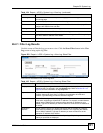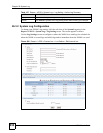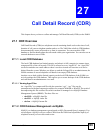
X6004 User’s Guide
239
CHAPTER 27
Call Detail Record (CDR)
This chapter shows you how to collect and manage Call Detail Records (CDRs) on the X6004.
27.1 CDR Overview
Call Detail Records (CDRs) are telephone records containing details such as the time of call,
duration of call, source telephone number and so on. The X6004 has a built in CDR database
that automatically stores calls made to or from its extensions. You can search the CDR
database to find out details about the calls made within your organization. You can also use an
external database to store CDRs.
27.1.1 Local CDR Database
The local CDR database has limited capacity and when it is full it empties its contents into a
compressed file of the call records. This file is referred to as an “Aged File”. An “Aged File”
can be forwarded to an e-mail address where it can be reviewed at a later time or it can be
deleted from the system. Whether you delete or send the full aged file to an administrator, the
X6004 continues to record telephone call details in an empty CDR database.
Another way to deal with the limited capacity on the local CDR database of the X6004 is to
actively manage the CDR database. This requires you to create backups of the CDR database
and send them to an administrator via e-mail.
27.1.1.1 Viewing Aged Files
An “Aged File” is a compressed file with the extension “.tgz”. “.tgz” files can be
uncompressed with data compression utilities for example WinRAR or WinZIP. The result of
decompressing this file are three files which can then be managed via a MySQL Database
Management System (DBMS). The three files are:
• cdr.MYD - a MySQL data file.
• cdr.MYI - a MySQL index file.
• cdr.frm - a MySQL format file.
27.1.2 CDR Database Management via MySQL
MySQL is a database management system based on SQL (Structured Query Language). You
can configure a MySQL server to collect CDRs from the X6004 and expand the capacity of
telephone records you can collect and review.


















